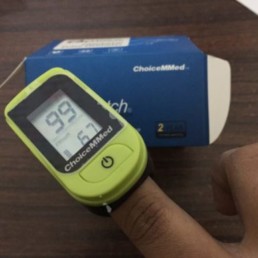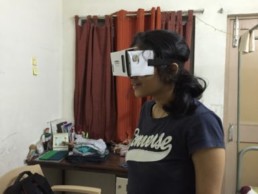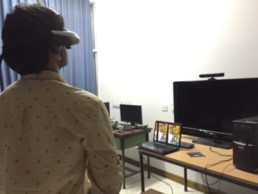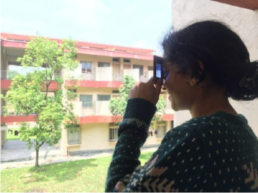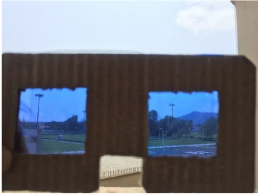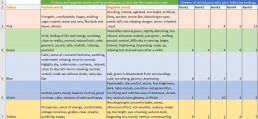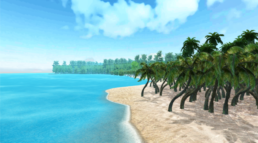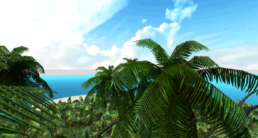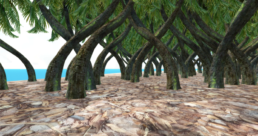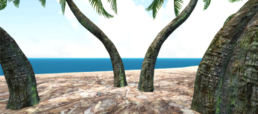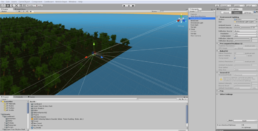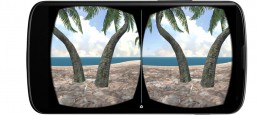Exploring the role of nature and virtual reality in helping people de-stress
Project Overview
Stress has become a common phenomenon nowadays hitting a fever pitch in every nation, primarily because of the modern lifestyle where people have no time for them to relax.
This project aims at highlighting the power of nature in providing quick relaxation and also explores the possibility of adopting virtual reality in giving an immersive de-stressing experience to people by simulating their presence in relaxing natural environments. Through testing of virtual reality relaxation environments, this project also proposes guidelines for designing such environments.
Bachelor Thesis Project
Skills: Literature Research, User Research, Affinity Analysis, Experiment Design, 3D Modeling and User testing.
Tools: Unity 3D
Duration: 8 months
Research Gap
In today’s fast‐paced and ever‐connected world, stress has become a fact of life. The existing stress coping methods are too obsolete to fit in the needs of the time-crunched world today. Hence, there is a need of a relaxation technique which can de-stress people in a short span of time, is accessible without any constraints, is effortless to adopt and is coherent with the modern lifestyle of people.
Design process followed to fill the research gap
LITERATURE RESEARCH
The literature research was carried out in three parts:
- Understand nature of stress, its types, causes, effects and measurement techniques.
- Study elements of nature and their benefits by referring to literature published in human ecology, environmental psychology and cognitive science.
- Study virtual reality (VR), its potential and usage in therapy.
Click here (Section 3, Literature Research) for in-depth literature research findings.
USER RESEARCH
Experiment 01: Testing the efficacy of natural elements among users when transported digitally
After identifying the elements of nature which are responsible for providing relaxation, it was required to test the efficacy of these elements when they are transported into a digital environment. For this purpose, five existing Virtual Reality Relaxation applications were selected to be tested with users after they met following criteria (based on findings from literature research):
- Presence of water because studies have indicated that the presence of water is experienced as particularly more relaxing and peaceful than just green natural environments.
- Presence of cool colors (towards the spectrum of blue-greens) because cool colors give a sense of calm.
- Presence of soft fascinations (clouds, sunsets, snow patterns, the motion of the leaves in the breeze and motion of waves in water) and extent. These two being major components of restorative environments according to Attention Restoration Theory.
Experiment Design
Objectives
- To measure the users’ emotional responses towards the 5 selected applications
- To identify the elements in the environments that appealed to them emotionally as well as visually
- To gain an understanding of their expectations of an ideal de-stressing environment
Selection of participants
To identify people who had had stressful thoughts in the last 24 hour (before trying these environments), a questionnaire was used, namely Perceived Stress Scale.
Location: Indian Institute of Technology Guwahati
No. of participants recruited: 20, 9 boys and 11 girls
Age range: 21-26
Before Experiment
An instrument called OxyWatch (Figure 1) was used to measure oxygen consumption and pulse rate before the experiment to keep these as a basis for comparing stress levels before and during the experiment. Because the pulse rate was always changing, peak value was taken into consideration.
OxyWatch (Figure 1)
This instrument was used to measure oxygen consumption and pulse rate of the participants before the experiment to measure their stress levels. When the user is stressed his/her oxygen consumption and pulse rate will be higher than normal.
During Experiment
The participants were shown the VR environments in the order of VR tour, Virtual Island, Relax Beach (Mobile based applications), Rest Relaxation, Guided meditation (Desktop based applications)
Duration of each application: 3-4 minutes
Their oxygen consumption and pulse rate readings were taken using OxyWatch.
Participants experiencing VR applications on Google Cardboard (left) and Sony HMD (right)
After Experiment
The participants were asked to give their feedback by filling out two questionnaires (Appendices A and B), one to be filled after looking at each environment and the other to be answered after the study. The questionnaires were designed to capture their emotional responses, identify the elements that they found restorative and understand their perception of an ideal natural environment.
Experiment 02: Identifying the color of light perceived as most relaxing
Objectives
- To record users’ emotional responses to different colors of light
- To obtain their preference order for most calming colors of light
Experiment Design
Four cardboards were taken with eye openings covered with four different colored cellophane sheets: pink, green, blue and yellow giving the respective tints to the environment when looked through. Participants were asked to look through these cardboards and record their responses in the response sheet (Appendix C).
Location: Indian Institute of Technology Guwahati
Number of participants: 25, 10 girls and 15 boys
Age range: 20-27 years
Cardboards with colored cellophane sheets to provide a colored tint to the background
Participant looking through cardboard (above), Environment tinted with color (below)
DATA ANALYSIS
Analysis Framework for Experiment 01 conducted during User Research
From personal observation and the elements as pointed out by the participants that they found relaxing and did not find relaxing, a list of variables were prepared which were then evaluated for each application. The framework designed for the analysis is shown below:
Findings from above analysis
The analysis gave an understanding of the elements of nature which make it restorative. Following is a list of elements of an ideal de-stressing environment as identified out of the above experiment:
- Cloudy sky over clear and sunny
- Tall and dense trees
- Presence of water
- Moving water over still water
- Coherent and subtle (not too loud) background sounds like of wind, birds, movement in water, trees swaying
- Less of browns and yellow in environments
- Light blue color over bright blue
- Less of green yellow
- No non-natural elements like chair, ships etc.
- No background instructions as it disturbs relaxation
- Instrumental soothing music without words
- Dim yellow light, no bright sunlight
Analysis Framework for Experiment 02 conducted during User Research
The framework shown below was designed to analyze the responses recorded by the participants. The analysis shows the positive and negative words corresponding to each color as experienced by the users and the number of people giving ranks to each color from 1 to 5.
Findings from above analysis
- 17 people out of 25 recorded blue as their first or second choices
- 12 people out of 25 recorded green as their first or second choices
- 10 out of 25 people placed violet at the third position where the first position is the most calming
- Pink was mostly perceived as artificial and disturbing by most of the people, hence 17 people out of 25 placed pink either at fourth or fifth positions
- Violet colored was created by combining blue and pink, hence it appeared relatively dark to people. A new experiment can be designed to see whether violet outpaces blue and green with same light passing through them
- Yellow had quite equal mixed reviews from people. People who found yellow calm said that it gave a sense of energy to them while people who found it disturbing said that it was too bright and resembled hot weather.
CONCEPTUALIZATION
Post data analysis, to conceptualize an ideal de-stressing environment, a list of characteristics was prepared:
- Should contain elements of nature as far as possible
- Should be able to de-stress within a short span of time, preferably 10-15 minutes.
- Should be accessible anytime and anywhere without the need of going to a particular place
- Should be digitally portable and transferrable
- Should give the user enough freedom to customize the application according to his/her needs like changing music, light of personal choice
- Should not require too much effort on part of the user for the smooth functioning of the application.
- Should be automated
- Should not lead to any discomfort physically
- Should maintain variability
- Should be available through a medium which is affordable and always accessible
3D MODELING
Description of 3D virtual environment designed
Using the elements of an ideal de-stressing environment, a relaxing virtual environment was designed and modeled in 3D using software called Unity.
Interaction of user with environment
- User looks down to move forward in the virtual reality
- User can rotate his/her head 360 degree to navigate through the scene
- As the user moves through the environment, he/she can see the trees and bushes moving gently in wind
- 3D spatial sounds of birds chirping, water waves and gentle wind relax the users as they move through the environment
- When the user near the water, the water level rises to eye level so that the user can clearly see the water waves flowing.
PROTOTYPING
Unity 3D was used to prototype the android mobile application for Google Cardboard.
USER TESTING
The application was checked for its effectiveness for initial feedback with five users. The users were asked to wear the google cardboard and experience the virtual reality for a couple of minutes as long as they are comfortable. After the experiment, the users were engaged in contextual inquiry. They were asked to describe their experiences and point out the good and bad in the application.
- The users liked the part when water comes into the picture and termed it as the best part of the environment. They found the water moving towards them relaxing.
- Some of the users reported mild simulator sickness due to auto-walk feature in the application.
- The users found the ground repetitive and desired more detailed environments.
- The sounds of the trees moving and water flowing synchronizing with the visual imagery were found pleasing by the users.
- The users put forward the desire to dive or swim in nature (simulate the experience of it)
- The users suggested if the sky could be changed to change the time of the day to go from dusk to dawn.
OTHER PROPOSED APPLICATIONS
- Virtual Reality Relaxation applications can be used by astronauts who go on long missions in space and are devoid of the natural environmental elements like sunlight.
- These applications can also be customized by therapists to treat stress.
